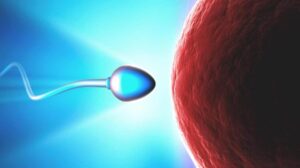Zero Sperm Count How To Increase – Why I’m Unable To Produce Sperm
Azoospermia is a condition in which a man’s ejaculate contains no sperm, or in simple words, men are unable to produce sperm.
Some factors contributing to it include a blockage anywhere along the reproductive canal, hormone disorders, ejaculation problems, and concerns with testicular anatomy or function. Many issues are curable, and fertility may be restored.
It may also be feasible to collect live sperm for assisted reproductive procedures if the original cause cannot be determined.
Table of Contents
An In-depth look at Azoospermia
What is Azoospermia?
Azoospermia is a condition in which a man’s ejaculate contains no detectable sperm (semen). Azoospermia causes male infertility.
How common is Azoospermia?
About 1% of all men and 10% to 15% of infertile men have Azoospermia.
Types of Azoospermia?
Obstructive Azoospermia: – This sort of Azoospermia indicates a blockage or missing link in the epididymis, vas deferens, or anywhere else along with your reproductive system. You are making sperm, but it is being prevented from exiting; therefore, there is no detectable quantity of sperm in your sperm.
Non-obstructive Azoospermia: – This sort of Azoospermia implies that you produce little or no sperm owing to problems in the structure or function of the testicles or other factors.
Diagnosis
Azoospermia is identified when your sperm sample displays no sperm when inspected under a high-powered microscope after a spin in a centrifuge on two different occasions.
A centrifuge is a laboratory apparatus that rapidly spins a test material to separate it into its constituent elements. If sperm cells are present in centrifuged seminal fluid, they separate from the fluid surrounding them and may be observed under a microscope.

Your healthcare professional will collect your medical history as part of the diagnosis, including questions regarding the following:
- Fertility success or failure (your ability to have children) in the past).
- Illnesses in children
- Injury or surgery in the pelvic region (these could cause duct blockage or poor blood supply to the testicles).
- Infections of the urinary or reproductive tract.
- There is a history of sexually transmitted illnesses.
- Radiation or chemotherapeutic exposure
- Your current and previous medicines
- Any alcohol, marijuana, or another substance misuse.
- Recent fevers or heat exposure include frequent saunas or steam baths (heat kills sperm cells).
- A family history of birth abnormalities, learning impairments, infertility, or cystic fibrosis.
Men Unable to Produce Sperm Might Have Higher Risk of Cancer
Male infertility costs men more than just their capacity to procreate — it might cost them their lives as well.
Interfile males, particularly those unable to generate sperm in their ejaculate, may be almost twice as likely as the general population to get cancer, according to a Stanford University School of Medicine research published in Fertility and Sterility.
The research included a total of 2,238 infertile males. There was no history of vasectomy among the males, and 451 had been diagnosed with Azoospermia or a lack of sperm.
From 1995 to the end of 2009, medical data indicated that 29 infertile males were diagnosed with cancer – roughly 12 more instances than a random sample of the general population would yield.
Those with Azoospermia have a twofold increase in cancer risk when compared to men who do not have Azoospermia.

A subanalysis found that the tendency was particularly pronounced in younger azoospermic males. As men’s ages declined, the study found that their cancer risk rose, with males under 30 having the most significant threat. These males are eight times more likely to get cancer.
Infertile males were 1.7 times more likely to acquire cancer than the population. Men with Azoospermia had a 2.9-fold higher risk than infertile men.
In a press release, lead author Michael Eisenberg, MD, Ph.D., assistant professor of urology at the medical school and director of male reproductive medicine and surgery at Stanford Hospital & Clinics, said, “An azoospermic man’s risk for developing cancer is similar to that of a typical man ten years older.”
The link between infertility and cancer types was not judged statistically significant. Yet, participants were diagnosed with various malignancies, including the brain, prostate, stomach tumors, melanoma, lymphoma, testicular cancer, and small intestine cancer. Previous research has established a link between infertility and testicular cancer.
This is the first research to find an association between Azoospermia and increased cancer risk. Future studies should look at the advantages of screening azoospermic men for cancer more often.
